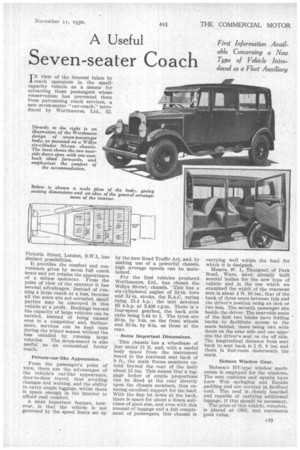A Useful
Page 79

If you've noticed an error in this article please click here to report it so we can fix it.
Seven-seater Coach
First Information Available Concerning a New Type of Vehicle Introduced as a Fleet Auxiliary
JN view of the interest taken by coach operators in the smallcapacity vehicle as a means for attracting those pasSengers whose conservatism has prevented them . from patronizing coach services, a new seven-seater "car-coach," introduced by Worthmores, Ltd., 32.
Victoria Street, London, S.W.1, has distinct possibilities.
It provides the comfort and convenience given by seven full coach seats and yet retains the appearance of a saloon motorcar. From the point of view of the operator it has several advantages Instead of running a large coach at a loss, because all the seats are not occupied, small parties may be conveyed in this vehicle at a profit. Bookings beyond the capacity of large vehicles can be carried, instead of being passed over to a competitor and, furthermore, services can be kept open during the winter season without the loss entailed by running large vehicles. The seven-seater is also useful as an economical feeder coach.
• Private-car-like Appearance.
• From the passenger's point of view, there are the advantages of the vehicle's car-like appearance, door-to-door travel, thus avoiding changes and waiting, and the ability to carry ample luggage, whilst there is space enough in the interior to afford real comfort.
A most important feature, however, is that the vehicle is not governed by the speed limits set up by the new Road Traffic Act, and, by making use of a powerful chassis, high average speeds can be maintained.
For the first vehicles produced Worthmores, Ltd., has chosen the Willys 30-cwt. chassis. This has a six-cylindered engine of 3i-in bore and 31-in. stroke, the R.A.C. rating being 25.4 hp. ; the unit develops 65 b.h.p. at 3,400 r.p.m. There is a four-speed gearbox, the back axle ratio being 5.44 to 1. The tyres are 30-in. by 5-in, on the front wheels and 32-in. by 6-in, on those at the rear.
Some Important Dimensions.
This chassis has a wheelbase of just under 11 ft. and, with a useful body space from the instrument board to the rearmost seat back of 9 ft., the main frame members extend beyond the rear of the body about 15 ins. This means that a luggage locker of ample proportions can be fixed at the rear directly upon the chassis members, thus ensuring excellent support for the load. With the flap let down at the back, there is space for about a dozen suitcases of good size, and even with this amount of luggage and a full complement of passengers, this chassis is
carrying well within the load fox which it is designed.
Messrs. W. L. Thurgood, of Park Road, Ware, have already built several bodies for the new type of vehicle and in the one which we examined the width of the rearmost seat is about 4 ft. 10 ins., that of the bank of three seats between this and the driver's position being an irich or two less, The seventh passenger sits beside the driver. The near-side seats of the first two banks have folding backs to facilitate access to the seats behind, there being two wide doors on the near side and one opposite the driver's seat on theoff side. The longitudinal distance from seat back to seat back is 2 ft. 9 ins, and there is foot-room underneath the seats.
Hobson Window Gear.
FIobson's 11Y-type window mechanism is employed for the windows. The seat cushions and squabs have Lace Web springing and Rapido padding and are covered in Bedford cord. The roof is closely boarded and capable of carrying additional luggage, if this should be necessary. The price of this vehicle, complete, is placed at 1395, and represents good value.




















































































































































